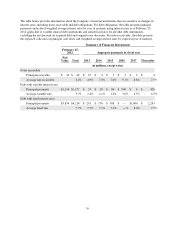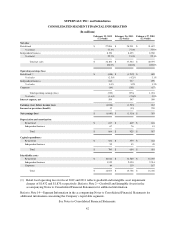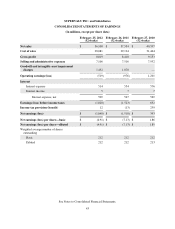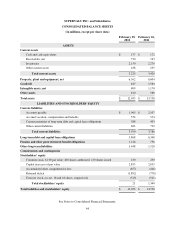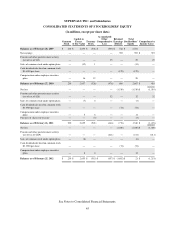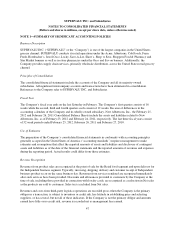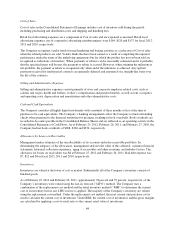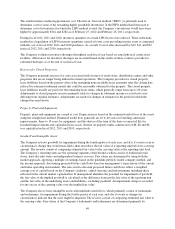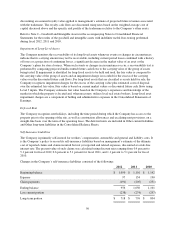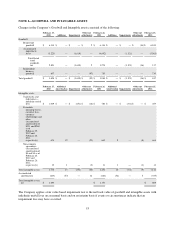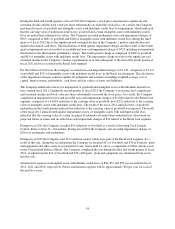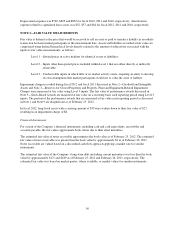Albertsons 2012 Annual Report Download - page 53
Download and view the complete annual report
Please find page 53 of the 2012 Albertsons annual report below. You can navigate through the pages in the report by either clicking on the pages listed below, or by using the keyword search tool below to find specific information within the annual report.The retail inventory method approximates cost. The first-in, first-out method (“FIFO”) is primarily used to
determine cost for some of the remaining highly perishable inventories. If the FIFO method had been used to
determine cost of inventories for which the LIFO method is used, the Company’s inventories would have been
higher by approximately $342 and $282 as of February 25, 2012 and February 26, 2011, respectively.
During fiscal 2012, 2011 and 2010, inventory quantities in certain LIFO layers were reduced. These reductions
resulted in a liquidation of LIFO inventory quantities carried at lower costs prevailing in prior years as compared
with the cost of fiscal 2012, 2011 and 2010 purchases. As a result, Cost of sales decreased by $19, $11 and $22
in fiscal 2012, 2011 and 2010, respectively.
The Company evaluates inventory shortages throughout each fiscal year based on actual physical counts in its
facilities. Allowances for inventory shortages are recorded based on the results of these counts to provide for
estimated shortages as of the end of each fiscal year.
Reserves for Closed Properties
The Company maintains reserves for costs associated with closures of retail stores, distribution centers and other
properties that are no longer being utilized in current operations. The Company provides for closed property
lease liabilities based on the present value of the remaining noncancellable lease payments after the closing date,
reduced by estimated subtenant rentals that could be reasonably obtained for the property. The closed property
lease liabilities usually are paid over the remaining lease terms, which generally range from one to 20 years.
Adjustments to closed property reserves primarily relate to changes in subtenant income or actual exit costs
differing from original estimates. Adjustments are made for changes in estimates in the period in which the
changes become known.
Property, Plant and Equipment
Property, plant and equipment are carried at cost. Depreciation is based on the estimated useful lives of the assets
using the straight-line method. Estimated useful lives generally are 10 to 40 years for buildings and major
improvements, three to 10 years for equipment, and the shorter of the term of the lease or expected life for
leasehold improvements and capitalized lease assets. Interest on property under construction of $6, $8 and $6
was capitalized in fiscal 2012, 2011 and 2010, respectively.
Goodwill and Intangible Assets
The Company reviews goodwill for impairment during the fourth quarter of each year, and also if events occur or
circumstances change that would more-likely-than-not reduce the fair value of a reporting unit below its carrying
amount. The reviews consist of comparing estimated fair value to the carrying value at the reporting unit level.
The Company’s reporting units are the operating segments of the business which consist of traditional retail
stores, hard-discount stores and independent business services. Fair values are determined by using both the
market approach, applying a multiple of earnings based on the guideline publicly traded company method, and
the income approach, discounting projected future cash flows based on management’s expectations of the current
and future operating environment. The rates used to discount projected future cash flows reflect a weighted
average cost of capital based on the Company’s industry, capital structure and risk premiums including those
reflected in the current market capitalization. If management identifies the potential for impairment of goodwill,
the fair value of the implied goodwill is calculated as the difference between the fair value of the reporting unit
and the fair value of the underlying assets and liabilities, excluding goodwill. An impairment charge is recorded
for any excess of the carrying value over the implied fair value.
The Company also reviews intangible assets with indefinite useful lives, which primarily consist of trademarks
and tradenames, for impairment during the fourth quarter of each year, and also if events or changes in
circumstances indicate that the asset might be impaired. The reviews consist of comparing estimated fair value to
the carrying value. Fair values of the Company’s trademarks and tradenames are determined primarily by
49


